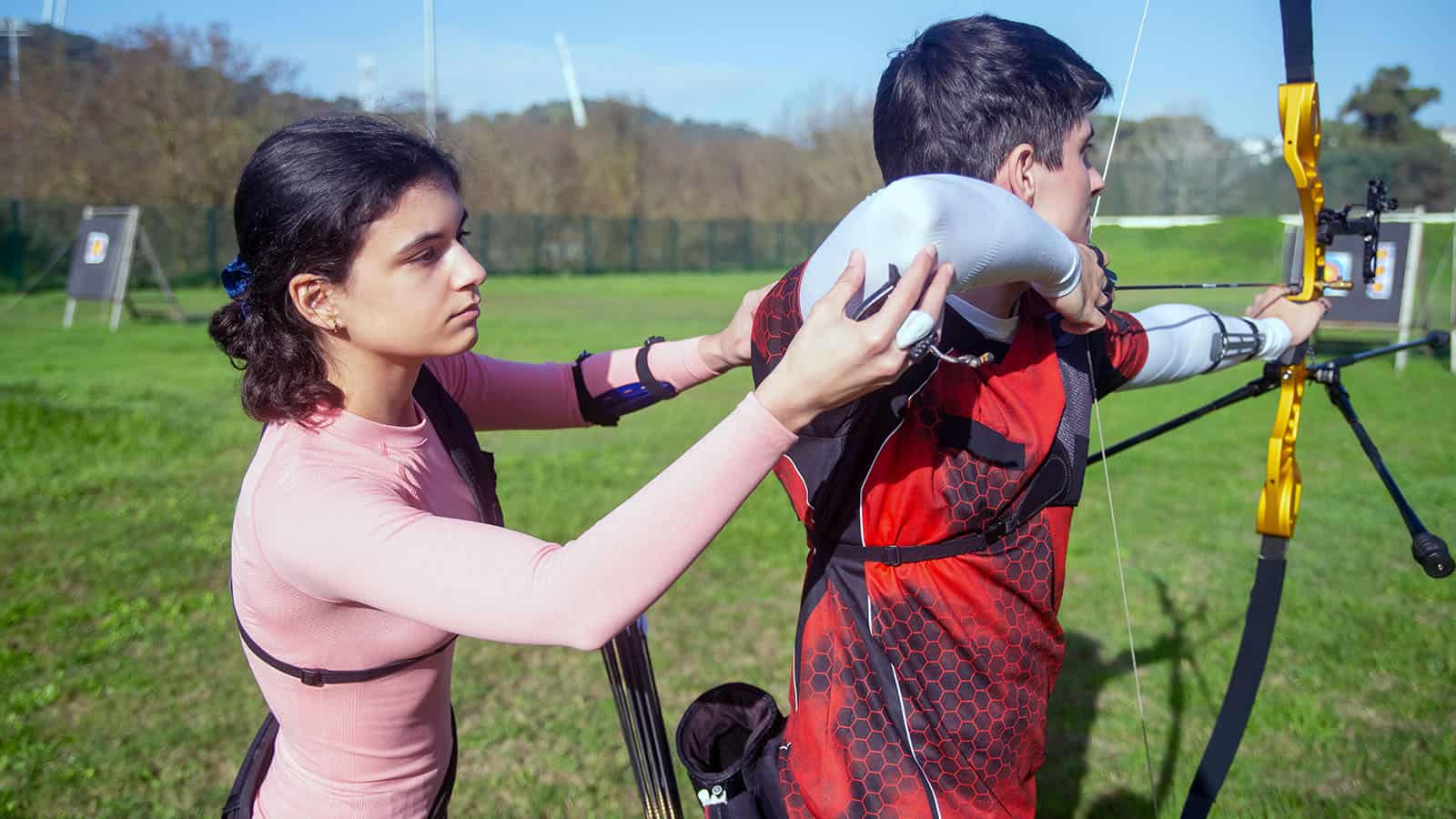Bow hunting is an absolutely fantastic sport. It allows you to practice your competitive edge. It also provides you with a way to put food on the table. That said, bow hunting is not as easy as just picking up a bow and shooting an animal. There is a lot more to it than that. This is why today we are here doing a comprehensive bow hunting guide for beginners.
We are going to provide you with all of the information you need to become a professional bowhunter. When it comes to bow hunting 101, choosing the right kind of bow is very important. However, choosing the right kind of arrows, the accessories and equipment, and more is all very important too.
You then need to know what kind of animals you can hunt for. Today, we’re going to cover all of these things and much more. This is a bow hunting 101 guide that will teach you everything you need to know In terms of archery basics for beginners. Let’s get to it and teach you how to start hunting.
What Kinds of Game Can I Bow Hunt?
When it comes to hunting for beginners, you need to know what types of game you can hunt. How to start hunting involves knowing what animal you plan on hunting for. What kind of bows, arrows, and accessories you choose often depend on the game You are hunting for. Let’s take a quick look at the different types of animals you can hunt for with a bow.
You can always hunt for large game. This includes animals such as goats, sheep, boar, bison, bear, elk, caribou, moose, and deer. You can then also hunt smaller game. These include animals such as squirrels, groundhogs, raccoons, skunks, rabbits, peasants, coyote, frogs, geese, pheasants, turkey, and more.
One of the best bow hunting tips for beginners is to start with large game. There is one simple reason for this, size. Large game is big, and that makes for an easy target. It’s much easier to hit a deer or an elk than it is to hit a squirrel or a rabbit. It might be wise for you to read up on deer hunting to find some basic deer hunting tips for beginners .
Small game are much smaller, faster, and more difficult targets. That said, small game can be fun to hunt. Many people like the challenge of hunting small game. Many people also just don’t want to have to deal with processing a large game animal. It’s a lot of work. If you’d rather go small game hunting, check out this guide to small game bow hunting for some of the best tips.
Choosing Your Bow
First things first, there are a few different types of hunting bows to be familiar with. Technically speaking, there are four main kinds of hunting bows that you can use.
The best starter bow for you will be one that is easy to use, simple to aim with, and doesn’t require much maintenance. The four main kinds of bows are compound, recurve, longbows, and crossbowsLet’s take a quick look at each of them to see which one is best for you.
Crossbows
Crossbows for beginners are often a good choice. This is because they operate more or less like a firearm. Simply cock the bow, set the arrow, and pull the trigger. This simple operation makes them very beginner friendly. A crossbow makes for a good beginner bow.
They’re just super easy to use. They also don’t require much movement on behalf of the user. The less movement there is, the less likely you are to scare away your prey. On that note, crossbows are also extremely accurate.
Most bow hunting experts would agree that crossbows are the most accurate of all. Something to take note of is that most of the compound bows for hunting are actually compound crossbows.
Crossbows can be somewhat expensive, although many agree that they are one of the best options to consider. If you are a beginner who needs something accurate and reliable, a crossbow is a good way to go. Just remember that due to the cost, they are quite the investment. This is definitely one of the best starter bows out there.
Here’s a great Barnett Whitetail Hunter Crossbow to check out.
Compound Bows
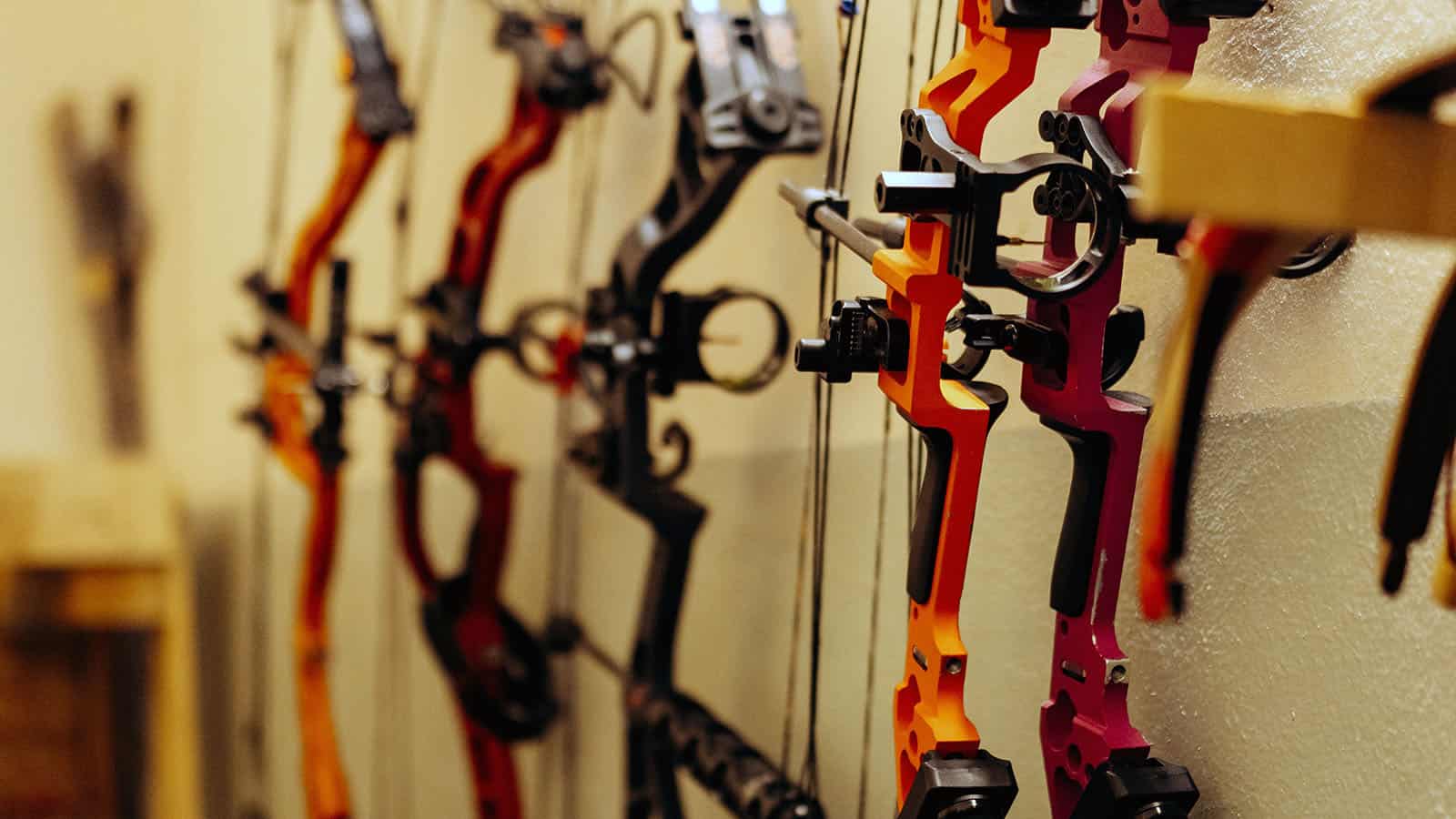
Another great type of bow that is commonly used for bow hunting is the compound bow. When compared to traditional bows, these are much easier to use.
The reason for this is because they have pulleys not to help to take some of the weight away from you. These police reduce the amount of pressure and strain on your shoulders and arms when you draw your boat.
Not only does this require less muscle strength, but it also allows you to aim better. You can easily hold your bow drawn for a few minutes before you release your arrow.
It requires so little effort that your arm should not get tired. This allows you to be silent while you wait for your game animal to approach or get you to position.
That said, many people have problems shooting moving targets with this type of bow. On the other hand, compound bows are ideal because they have plenty of room for accessories. They easily fit many different types of bow hunting sights and much more.
Compound bows can also be somewhat expensive, although usually not as much as high end compound crossbows. If you want more of the traditional bow hunting experience, the compound bow is ideal. This is especially the case when compared to a crossbow, which is not very traditional at all.
A compound bow is a good mix of old and new. It features an old school design with new age technology to help make life a bit easier. It’s not quite as simple as point and shoot like with a crossbow.
However, it’s also not quite as difficult as using a much older recurve bow or Longbow. Yes, you guessed it, those are the next types of bows we’re going to look at. Before we move on, check out this video on choosing the right bow for you. There are plenty of beginner friendly compound bows out there.
Recurve Bows and Longbows
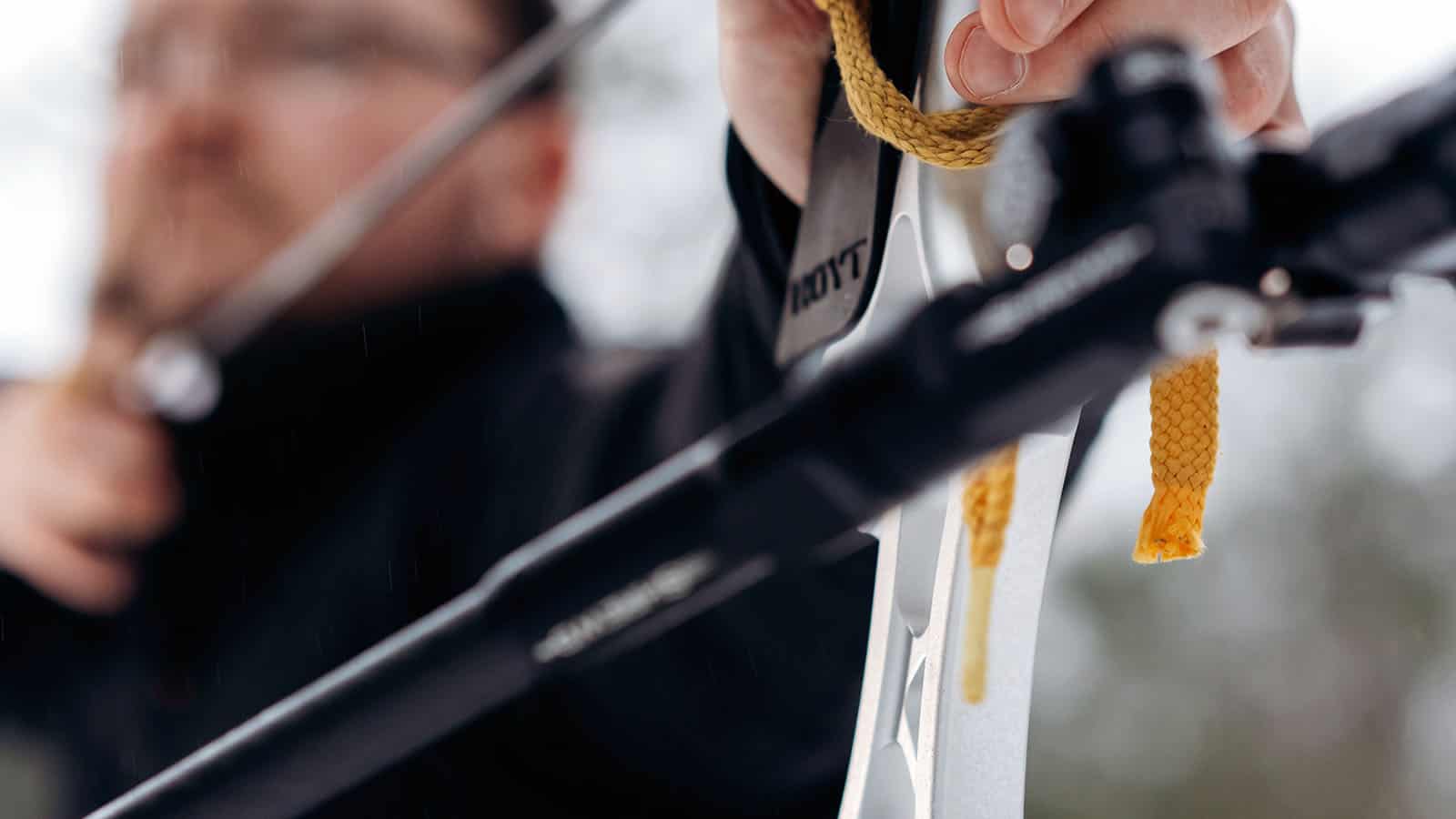
These are technically two different types of bows. With that being said, in regards to hunting for beginners, they have more or less the same features. Longbows are generally a bit longer and can shoot further, but that’s really the only fundamental difference. This is especially the case as far as beginner bow hunters are concerned.
One of the biggest drawbacks with these types of bows is that it takes a lot more muscle to use them. Unlike a compound bow that has pulleys, with recurve and longbows, they rely on your own strength.
This means that it either requires more strength on your behalf, or you just won’t be able to draw your bow as far back. Whether you can’t draw your bow as far back, or you can’t hold it drawn for as long, your experience is impacted here. This makes it much harder to aim and to remain quiet.
You can’t really hold these types of bows drawn for a long time as you wait for game to approach. These bows are designed more for a very quick draw and release. This means that you have to be good at aiming very quickly.
Recurve bow hunting for beginners can be difficult to master. Although, many people enjoy the traditional experience. These bows feel and look very traditional.
However, many people do like these bows for shooting moving targets. They’re often used for small game like squirrels, rabbits, and even birds. All that said, if you are on a budget, both longbows and recurve bows are good options. Longbows and recurve bows are generally cheaper than compound bows and compound crossbows.
How to Choose the Best Bow Hunting Spots
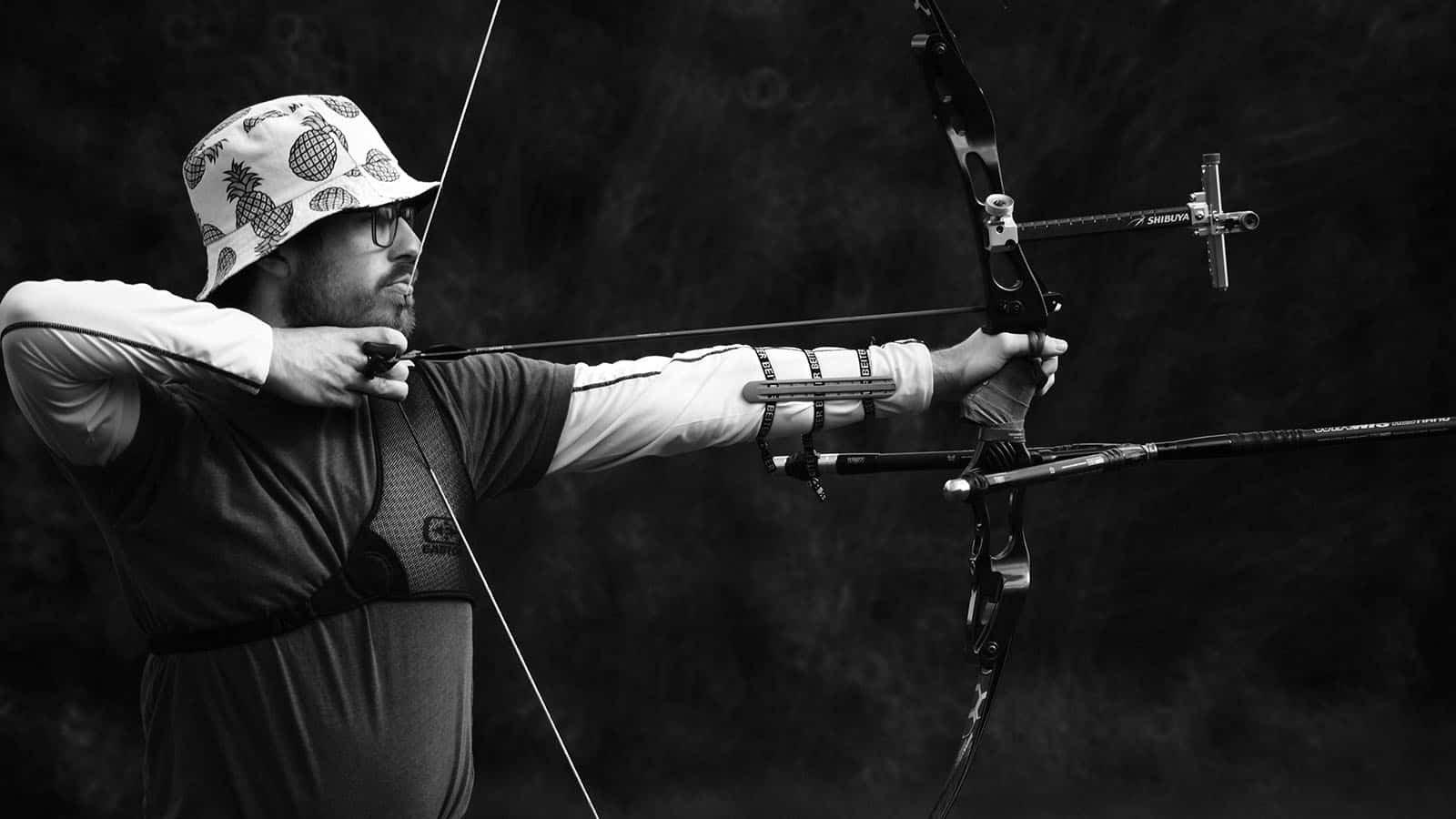
One thing you certainly need to do is to choose the right spot to hunt in. Follow the tips as listed below to find the best bowhunting locations for you.
- One of the best things you can do to choose a good bow hunting spot is to ask locals. Local hunters should know where all of the best spots are.
- When choosing a hunting location, always find the right tree.You want a tree that has a fairly clear trunk, you don’t have to clear too many branches off.You also want a tree that is sturdy andappears to be in good health. That tree should have a good view of the surrounding area, and allow for a clear shot when needed.
- To choose a good hunting spot, always pay attention to the wind direction. You never want to be upwind from animals because they’ll be able to smell you.
- If you can find an area such as the back of a ridge or at the lip of a ravine, these are good areas. These act as natural funnels for animals that you can then hunt. It’s always a good idea to have high ground as well.
Other Important Bow Hunting Equipment
Not only do you need the right kind of bow, but there are other pieces of equipment you’ll require as well. If you expect to learn to bow hunt, familiarizing yourself with the equipment is essential. Check out this article for more info on bow hunting gear.
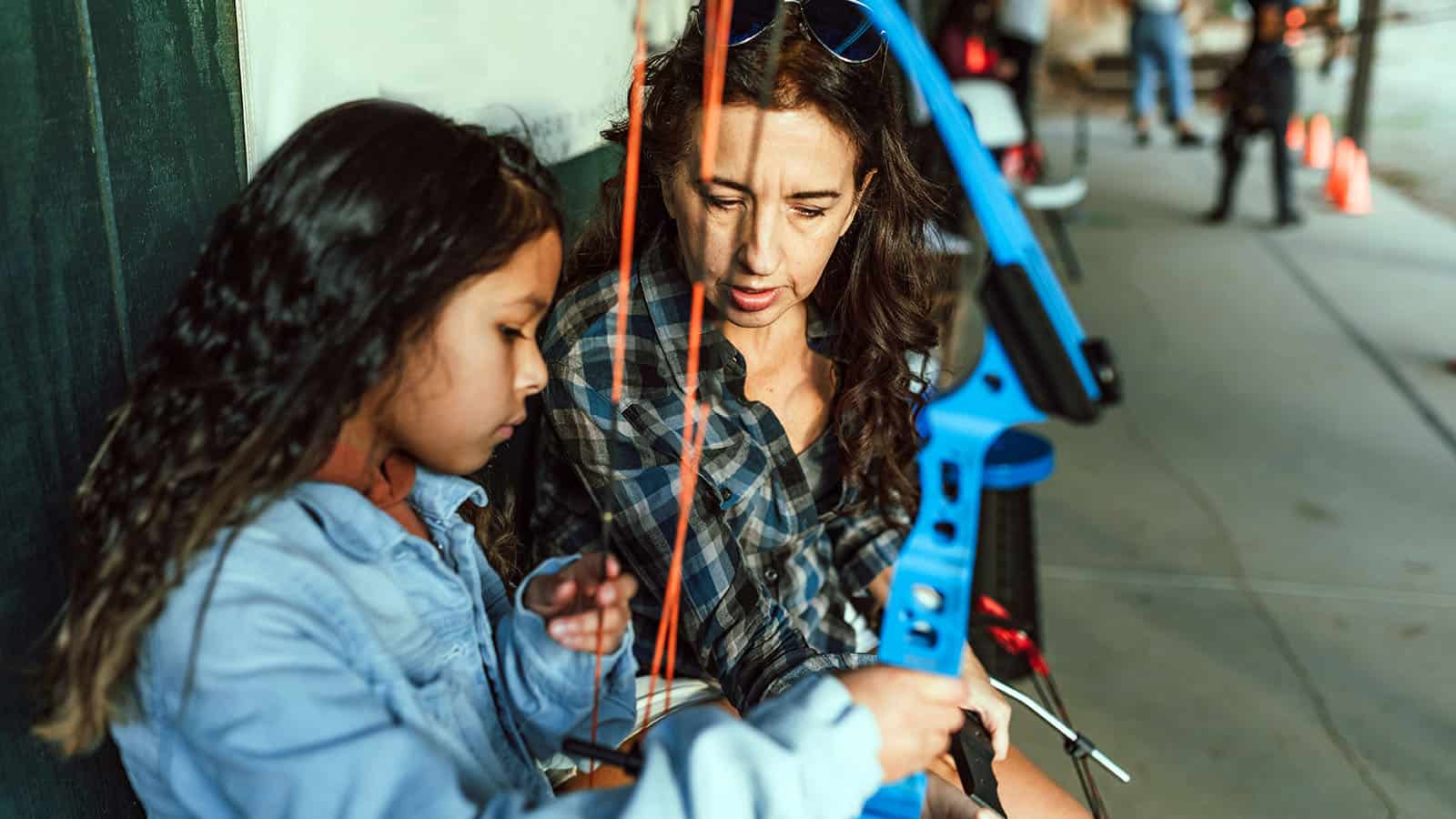
Bow Sights
The first thing you will need is a bow sight. A bow sight is really no different than a sight on a firearm. It helps you aim, judge distance, and make an accurate shot. There are a few different types of bow sights.
These include single pin bow sights, multi-pin bow sights, pendulum sights, and even magnifying sights.
Which one you prefer is really more a matter of personal preference than anything else. A multi pin sight may have 3, 5, or 7 pins. These can be adjusted to correspond with various distances. If you have a 7-pin sight, you can set those pins to seven different distances.
A 3 pin bow sight like this one from Trophy Ridge could be right for you.
These are good for accurate aiming if the distance to the game animal corresponds with the distance on the sight. However, they can be a bit confusing and overwhelming because there’s so much going on. If you don’t know which penny you are looking at, you’ll have trouble aiming.
If you don’t know which pin corresponds with what distance, you’ll also have trouble. Therefore, for beginners, a single pin bow sight may be best. There is a lot less to focus on, only a single pin. However, because there is only a single pin, you’ll have to make adjustments on the go.
If you are shooting out of a tree stand or on uneven terrain, pendulum sight might be best. Pendulum sights are ideal when you aren’t holding your bow completely horizontally.
They are ideal for shooting uphill and downhill, or out of trees. The sight stays perpendicular to the ground no matter your position. Therefore, a pendulum sight might be best for you. When it comes to beginning archery equipment, this is one of the most important pieces of all.
Release, Finger Tab, or Glove
Any archery for dummies lesson will tell you that a glove, finger tab, or release is required. These are all different things that achieve the same result.
These items allow you to draw the bow string with minimal effort. They also allow you to hold the bowstring drawn with minimal effort. Then, these accessories also help you release the string and your arrow with great accuracy and precision.
If you are going the traditional route, you might go with a glove or even finger tabs. They allow for quite a natural feel, and many people prefer them. However, as a beginner, you might want to go for a trigger release.
A trigger release physically holds the string in place. It then requires you to use a finger or thumb to press a button, which then releases the string.
If you are going for accuracy, a trigger release is best. A trigger release also allows you to hold the string in place with virtually zero effort. This allows you to be silent and patient as you wait for a game animal to approach. As a beginner, we recommend you stick with a trigger release. This LWANO Archery compound bow release could be ideal for you.
Arrows and Arrowheads
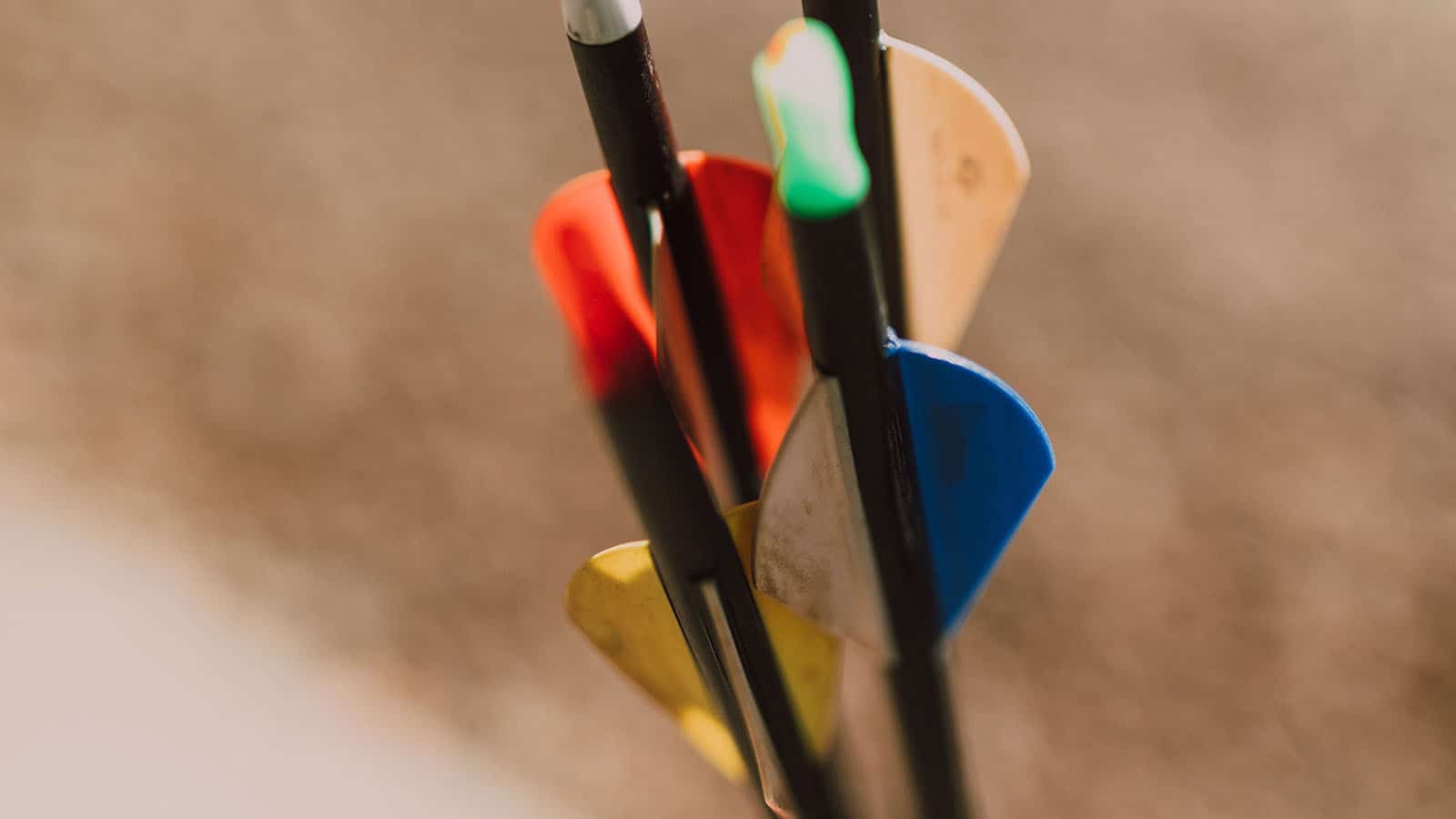
The next step here is to purchase your arrows and arrowheads. There are four main types of arrow materials to consider. These include wooden, aluminum, carbon, and fiberglass arrows. If you are going for something light, quiet, and affordable, wooden arrows are best. However, wooden arrows bend easily and require a lot of maintenance.
We then have aluminum arrows. These also tend to be quite durable, have good penetration, and are affordable. However, they don’t offer the best performance when compared to some other options.
This is especially the case when referring to carbon arrows. Carbon arrows are usually lighter, stiffer, harder and straighter, and more accurate. However, carbon arrows are also more expensive.
We then have fiberglass arrows. Fiberglass arrows are by far the most durable types of arrows. They aren’t quite as accurate or useful, but they are popular for beginner bow hunters. They can take a lot of punishment before they break. A drawback with them however is that they are extremely heavy, so their flight speed is limited.
You must then also consider the arrowhead type. Different types of heads include bullet, field, blunt, grabbing, bowfishing, and broadhead points. These Dead Ringer Broadheads are great for beginners!
If you are going for small game, something like a blunt point arrow will do just fine. Another arrowhead type of choice for hunting is the broadhead. As a beginner, use either a broadhead or bullet point for larger game, or a blunt arrowhead for smaller game. Check out the best broadheads right here!
A Quiver
We’ve covered all of the most important accessories and equipment now. However, there is still more you will require. One thing you will need is a quiver. This is the item that holds your arrows while they are not in use. There are three main types of quivers. These include bow mounted quivers, back quivers, and hip quivers.
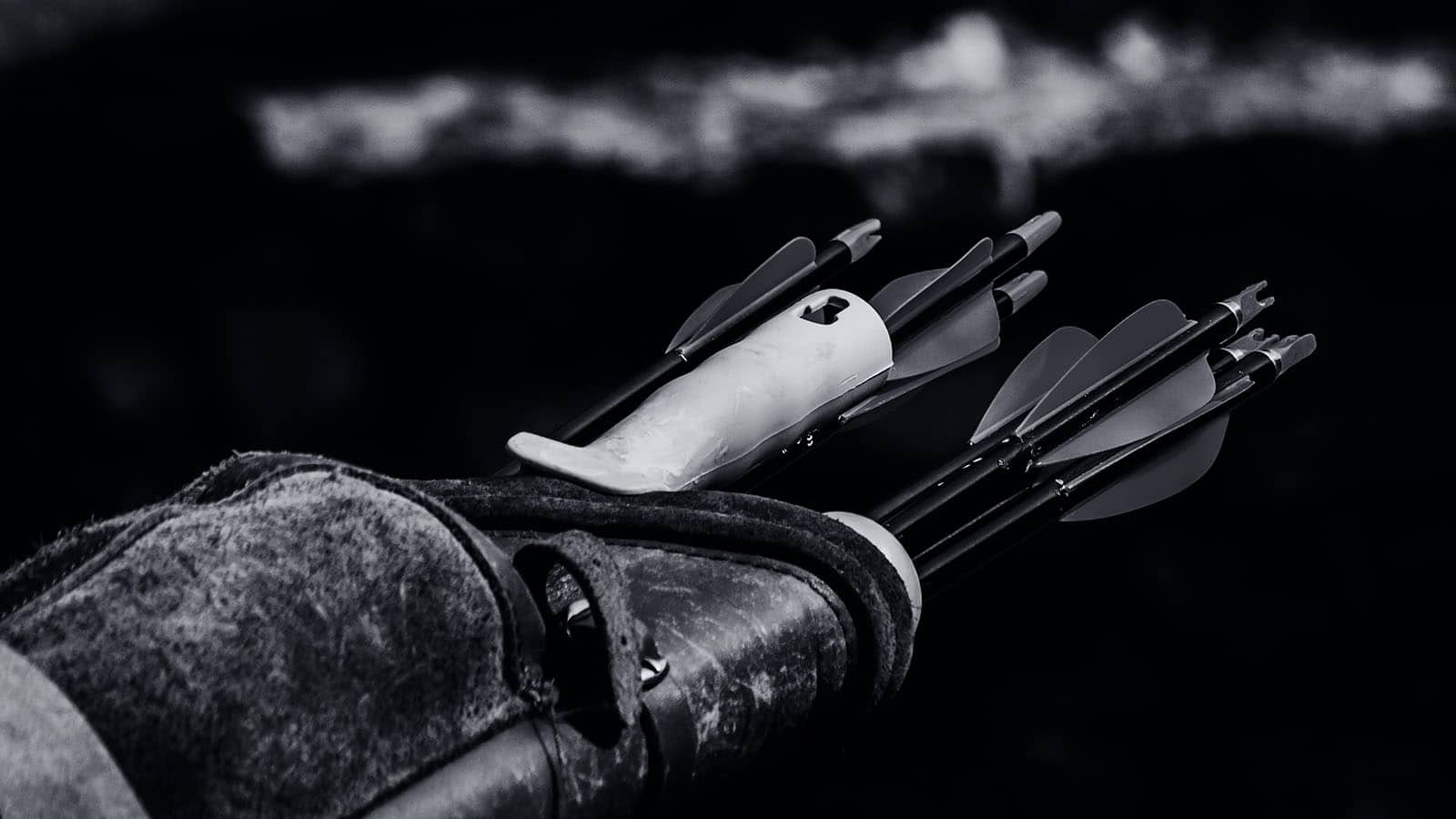
Here’s a good beginner quiver to check out!
Which of these you choose really depends on your personal preference. Some people prefer having bow mounted quivers. This allows the arrows to be as close to the bow as possible. This allows for fast and sequential firing of arrows. However, in terms of comfort, both back quivers and hip quivers tend to be better.
A Tree Stand
Another piece of equipment to consider is the tree stand. If you are doing stationary hunting, a tree stand is recommended. A tree stand allows you to sit high up in a tree comfortably. It allows you to wait for game in silence. You can sit comfortably in a tree, remain silent, and wait for your prey to approach.
There are various types of tree stands to consider. You have the climbing tree stand. A climbing tree stand is very portable. These allow you to climb into a tree and stand there. You can easily attach and detach them from various trees. This is ideal if you just want to quickly climb a tree to check out a spot, and then move on.
You then have the hang-on tree stand. These are a bit stronger and more stable. They’re designed to allow you to sit up in a tree for longer periods of time. They’re still fairly portable, but not quite as much as climbing tree stands. These hang-on tree stands can however be a bit difficult to get into.
The final type of tree stand to consider is the ladder tree stand. These aren’t overly portable, but they are stable. They’re designed to stay up in a tree for a long period of time.
Most people would put these in a tree for a whole season. They usually have big platforms and provide you with plenty of space for comfort. This is the kind of tree stand you would use if you plan on sitting in the same tree all day.
Here’s a really cool Big Game Hunter Ladder Stand worth checking out.
Animal Calls
An important archery hunting tip is to always bring along your animal calls. Sure, sitting in a tree stand and waiting is perfectly fine. However, it doesn’t hurt if you have the tool to help lure the animals towards you.
The Right Clothing
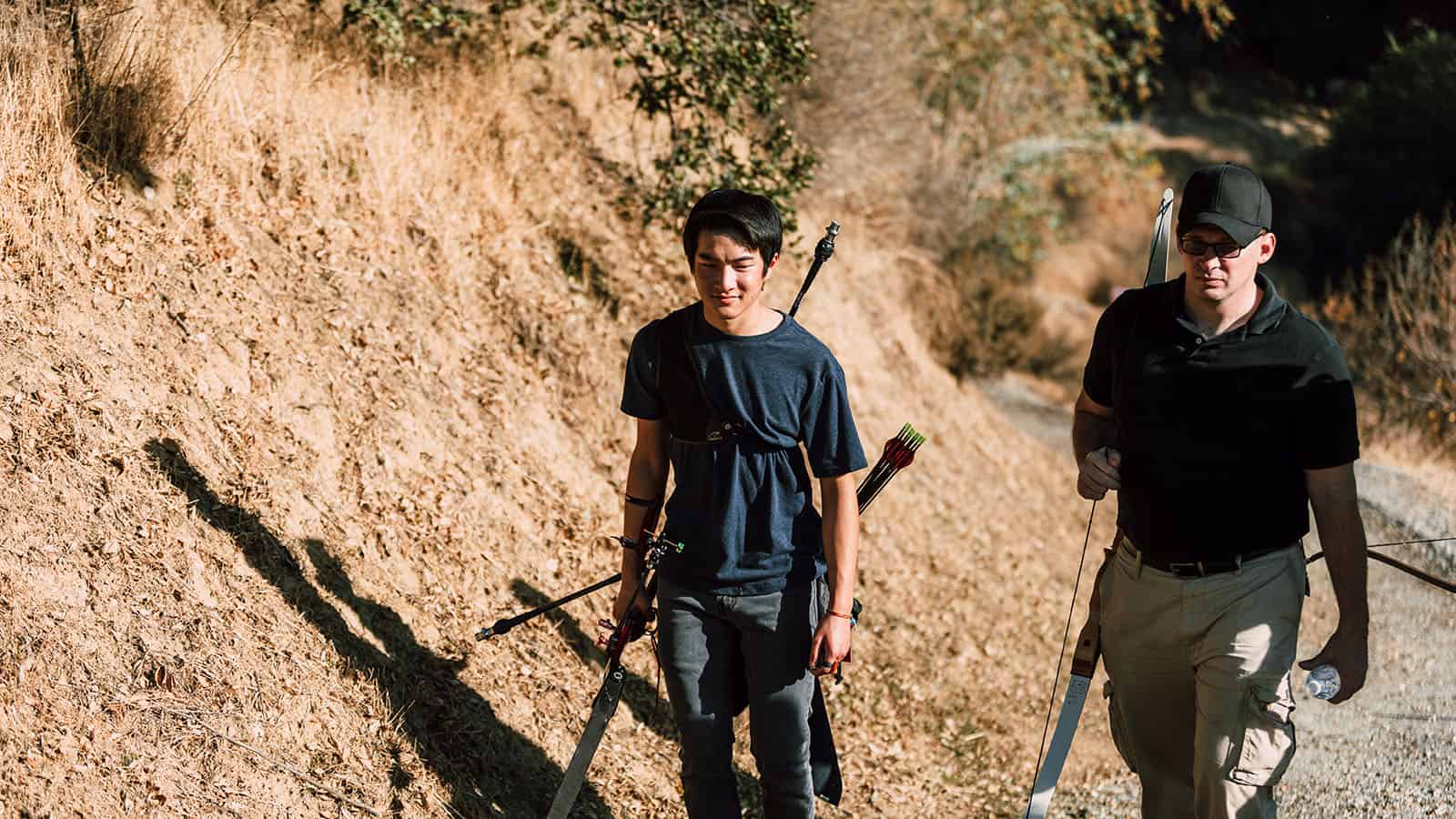
Although not exactly a hunting accessory, bringing the right kind of clothes is important. This is especially the case if you are hunting in cold or wet weather. You want an interior layer that will insulate you, something soft and warm. You then want a middle layer that is going to keep even more warmth in.
Preferably, you also want an exterior layer that is waterproof and windproof. Besides that, make sure to bring waterproof boots, gloves, and a hat. You may also want to bring some spare socks just in case. There’s nothing worse than hunting in wet and cold conditions, and not being properly clothed. This article can also provide you with more info about hunting clothes.
Archery Basics for Beginners
We have covered what kind of animals you can hunt for, the best bows for hunting, and the equipment you need. However, none of this will do you any good if you don’t know how to shoot a bow. Therefore, right now, we’re going to teach you exactly how to fire a bow for hunting. This is a multi-step process, and it requires a good deal of practice.
The Right Stance
Shooting your bow properly all starts with having the right stance. You should be facing your target head on. Your feet should be roughly shoulder width apart. The arm you use to grip your bow should point directly at your target.
Holding Your Bow
To fire accurately, you also need to hold the bow properly. You should support the bow with the web of your hand.
Don’t use your fingers or your palm, and don’t apply too much pressure. When the bow is fully drawn, you should be able to wiggle your fingers a little bit. You don’t need to grip the bow very hard at all. Rather, the weight of the draw should hold the bow in place for you.
In other words, when you draw the string, it will create pressure that will hold the bow in place. The point here is that your hand needs to be relaxed. If your hand isn’t relaxed, you will induce what is known as bow torque. This causes the bow to twist when the string is released because you are holding the bow too tight.
Drawing the Bow
The next step here is to draw your bow. Drawing your bow actually involves two separate motions. With your grip hand, that you are holding the bow with, push it towards your target. So, if you are right-handed, you will hold the bow with your left hand.
This means that you want to extend your left hand toward the target. Just don’t lock your elbow, because you want some flexibility.
The second aspect involves your release hand. This is the hand that holds the string and the arrow. Pull the string back towards you and across your chest. When fully drawn, your release hand should be pointing up and back toward the sky. When drawing your bow, use your back muscles, not just your shoulder muscles.
You should come to what is known as an anchor point. This is a consistent and solid place on your face that your hand sits at when the bow is fully drawn. Many people use the point of the jaw or the corner of the mouth for this.
This is a natural spot that you can easily replicate each and every single time. This is where you will release the arrow from. It therefore needs to be a comfortable and natural position.
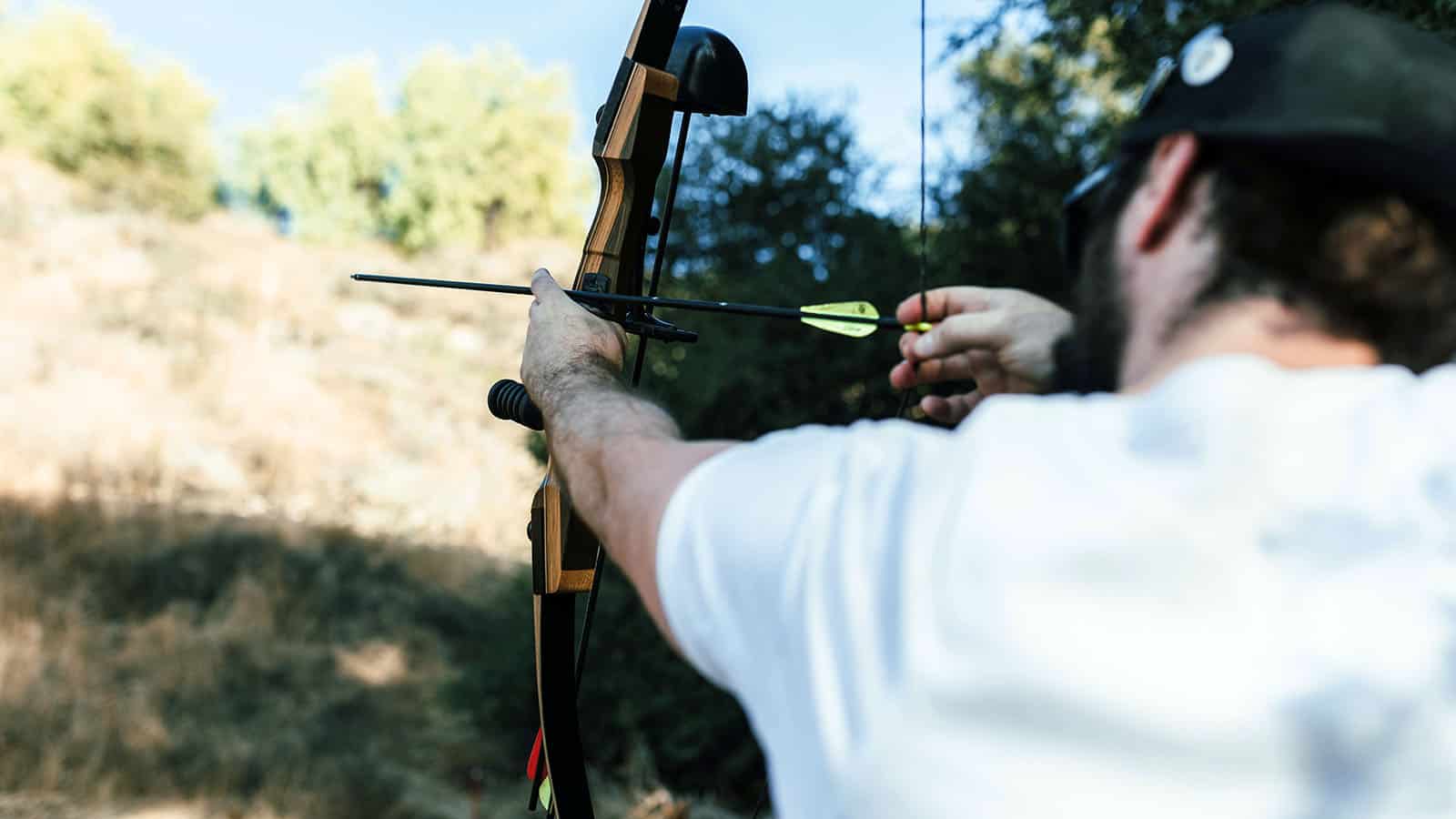
Proper Aiming
A big mistake many people make is closing one eye when aiming. Always keep both eyes open when aiming. Also, don’t pick a whole target to aim at. Rather, pick a small spot on the target to aim at. For instance, don’t aim for the rabbit, aim for the rabbit’s neck.
Now, aiming is one of the hardest parts here. We could write a whole guide on aiming. Most people will tell you to aim slightly above the target. The further away from the target you are, the more above it you need to aim. Remember, gravity is going to pull your arrow downwards. You need to compensate for this.
You should also do some research in terms of the best place to shoot various game animals. For instance, a beginner should never take a shot from the front.
An animal presents a much smaller target when being shot from the front. You want to shoot an animal when it shows you its broadside or the length of its body. It allows for a much bigger target that is much easier to hit.
Releasing the Arrow
The final step here is to release the arrow. A good tip here is to take a deep breath and then squeeze your trigger release as you are slowly letting it out. A good tip is to keep your bow in hand and in position until your arrow hits its target.
Final Thoughts
If you want to go on a challenging adventure, bow hunting is always recommended. That said, as a beginner, you might want to take some bow hunting lessons. Just a few bow hunting lessons can provide you with the skills and knowledge you need to be successful on your first real hunt.
